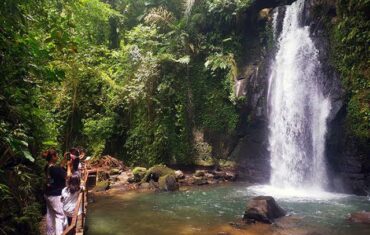Taman Ayun Temple
Nestled amidst lush gardens and encircled by a tranquil moat, Taman Ayun Temple stands as a majestic testament to Bali’s rich history and enduring spiritual heritage. More than just a place of worship, this Royal Temple of Mengwi offers a captivating experience, inviting visitors to step back in time and immerse themselves in its serene beauty and architectural grandeur. Recognized by UNESCO as a World Heritage site, Taman Ayun is a must-visit destination for those seeking to explore the cultural heart of Bali.

A Glimpse into History: The Royal Legacy of Taman Ayun temple
Founded in 1634 by the then King of Mengwi, I Gusti Agung Putu, Pura Taman Ayun, which translates to “Beautiful Garden Temple,” served as the main state temple for the Mengwi Kingdom. It was built as a place for the royal family to worship their deified ancestors and connect with the Hindu deities. The temple’s strategic design and expansive layout were intended to symbolize the mythological Mount Meru, the abode of the gods, and reflect the kingdom’s power and prosperity. Over the centuries, Taman Ayun has undergone several restorations, meticulously preserving its historical and architectural integrity.
Architectural Marvel: A Symphony of Balinese Design and Cosmic Symbolism

Taman Ayun is famous for its stunning traditional Balinese architecture, characterized by multi-tiered shrines known as meru, intricately carved wooden gates, and serene water features. The temple complex has three distinct courtyards, representing the Balinese cosmological concept of Tri Mandala:
- Nista Mandala (Jaba Pisan): The outermost courtyard, accessible after crossing a picturesque bridge over the surrounding moat. This area features open grassy spaces, a beautiful fountain, and a wantilan pavilion often used for community gatherings and traditional performances.
- Madya Mandala (Jaba Tengah): The middle courtyard, reached through a beautifully carved candi bentar (split gateway). This section houses various ancillary shrines and pavilions, including the Bale Kulkul (a tower for the traditional slit drum). The tranquil ambiance is enhanced by well-manicured gardens and fish ponds.
- Utama Mandala (Jeroan): The innermost and most sacred courtyard, accessible only to praying devotees during ceremonies. This hallowed space contains the towering meru shrines, with varying numbers of tiers (up to eleven) dedicated to different Hindu gods and the deified ancestors of the Mengwi royalty. Even from outside this inner sanctum, visitors can marvel at the majestic silhouettes of these iconic structures.
A distinctive feature of Taman Ayun is its orientation towards Gunung Batukaru, unlike most Balinese temples which are aligned towards Gunung Agung. The temple’s design also beautifully integrates water elements, reflecting the importance of the subak irrigation system, which is also part of Bali’s UNESCO World Heritage cultural landscape.
Why Taman Ayun Captivates Visitors: More Than Just a Temple

Taman Ayun’s allure extends beyond its religious significance. It’s a place where visitors can:
- Admire Architectural Beauty: Marvel at the intricate carvings, towering meru, and the overall harmonious design of the temple complex.
- Experience Serenity: Stroll through the peaceful gardens, listen to the gentle sounds of water, and enjoy a respite from the bustling tourist spots. The expansive green lawns and lotus-filled ponds create a calming atmosphere.
- Learn About Balinese Culture: Gain insights into Balinese Hinduism, royal history, and the island’s unique architectural traditions. An on-site museum, the Ogoh Ogoh Museum (located near the temple entrance), showcases traditional giant puppets.
- Capture Stunning Photographs: The temple’s picturesque setting, with its moats, gardens, and iconic shrines, offers countless opportunities for beautiful photos.
- Witness Local Life: If visiting during a temple ceremony (odalan), you can observe Balinese people in their traditional attire. Also making offerings and participating in sacred rituals, providing a deeper cultural experience.
UNESCO World Heritage Recognition: A Testament to Cultural Significance

In 2012, Taman Ayun Temple was inscribed as part of the “Cultural Landscape of Bali Province. The Subak System as a Manifestation of the Tri Hita Karana Philosophy” by UNESCO. This recognition highlights the temple’s crucial role not only as a spiritual center. But also as an integral part of the island’s unique and sustainable irrigation system. Which reflects the Balinese philosophical concept of harmony between humans, nature, and the divine.
>> Taman Ayun by wikipedia
Planning Your Visit to Taman Ayun: Practical Information
- Location: Taman Ayun Temple is located in Mengwi, Badung Regency, approximately 18 kilometers northwest of Denpasar. It is easily accessible from popular tourist areas like Ubud, Seminyak, and Kuta.
- How to Get There: The most convenient way to reach Taman Ayun is by renting a scooter or car with a driver. Several organized tours also include Taman Ayun in their itinerary.
- Best Time to Visit: The dry season (April to October) generally offers the most pleasant weather for exploring the temple. Early morning or late afternoon visits are better to avoid the midday heat and larger crowds. The temple is typically open daily from 8:00 AM to 6:00 PM.
- Entrance Fee: Visitors will pay an entrance fee, which contributes to the temple’s upkeep. Prices may vary, so it’s advisable to check the latest information.
- Dress Code: As Taman Ayun is a sacred site, visitors should dress politely. This means wearing clothing that covers the shoulders and knees. Sarongs and sashes are usually available for rent at the entrance if needed.
- What to Bring: Comfortable walking shoes, sunscreen, a hat, and a camera.
>> Read also Entrance Fee Pricelist of Bali Attractions
A Journey of Beauty and Tranquility Awaits
Taman Ayun Temple offers a unique and enriching experience for anyone visiting Bali. Its captivating blend of historical significance, architectural splendor, and serene natural beauty makes it a truly unforgettable destination. Whether you are a history enthusiast, an architecture lover, or simply seeking a peaceful retreat. A visit to Taman Ayun also promises a deeper understanding and appreciation of Bali’s enchanting cultural tapestry.
Additionally, please check on our services:








